What is the box and 1 offense
The box and 1 offense is a basketball offensive strategy that seeks to limit the effectiveness of the box and 1 defense by utilizing a series of off-ball screens and continuity patterns to create multiple scoring opportunities for the offensive team’s best player as well as additional players.
What are examples of scoring options for the box and 1 offense
For the diagrams below, 2 is the offensive team’s best player and therefore, X2 executes man to man defense while the other defenders would execute a zone defense.
Moreover, the four zone defenders that would form the box near the high post elbows and low post blocks are not shown on the diagram to keep it simple.
However, to briefly state their responsibilities, the two zone defenders at the top near the elbows would primarily cover the wing areas, the top, or the middle of the high post, which is sometimes referred to as the nail.
Furthermore, the two zone defenders at the bottom near the low post blocks would be responsible for guarding the corners as well as ball side low post players, or they would generally protect the basket in the middle of the lane. Additional details about this information and much more could be found on the box and 1 defense web page.
Affiliate Disclosure : I may earn a commission on qualifying purchases made through the links below.
Example 1 – Part 1
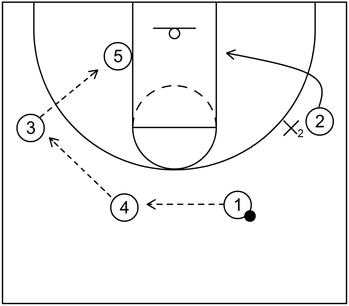
This is an example of a scoring option for the box and 1 offense derived from Attacking the 1-3-1, 2-3 and Box-and-1 Defense by Jerry Petitgoue.
To begin, X2 prevents 2 from receiving the ball with denial defense. When that occurs, 4 receives the ball from 1 and then, 3 receives the ball from 4. As that occurs, 2 cuts to the right side low post block.
Additionally, 5 could receive the ball from 3 if the bottom zone defender on the ball side does not front to take away the post entry pass. Afterwards, 5 could score with a low post move.
Example 1 – Part 2
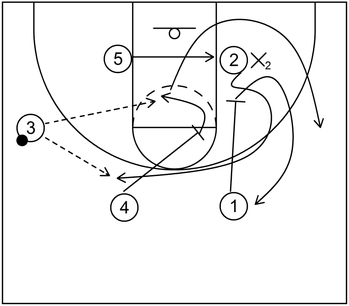
If 5 was not able to receive the post entry pass, then 2 cuts to the left slot area by way of stagger screens set by 1 and 4. Also, at the same time, 5 cuts across the lane to fill the recently vacated right side low post area.
Additionally, after setting the screens, 4 could slip to the middle of the lane while 1 could self replace at the right side slot area.
From that point, 2 could receive the ball and take the open jump shot or 4 could receive the ball and either shoot the short jumper in the lane or attack the basket to score near the rim.
Also, if 4 does not receive the ball, then 4 cuts through to the right side wing area.
Furthermore, it should be noted that although 2 is the team’s best player, it is actually 4 who should be the primary option during the slip screen action.
The reasoning behind this is that the top zone defender would most likely be preoccupied with keeping an eye on 2.
Moreover, the bottom zone defenders would possibly be focused on covering 5 during the cut across the lane. When that happens, the defenders may not see 4 (or whichever player would slip) in the middle of the lane.
This, in turn, creates scoring opportunities for an offensive player (in this case, 4) that was probably not on the defensive team’s scouting report.
Example 1 – Part 3
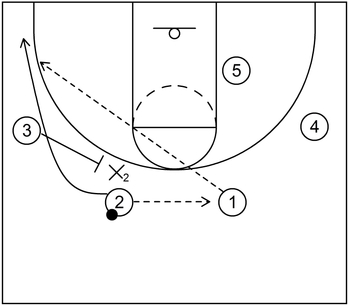
If 2 receives the ball from 3 but does not take the jump shot, then 1 could receive the ball from 2. Following that, 2 could cut away towards the left side corner via the flare screen set by 3.
Afterwards, 2 could receive the ball from 1 and either take the open jump shot or potentially dribble drive to the basket if the zone defender guarding the corner executes a poor closeout.
Example 1 – Part 4
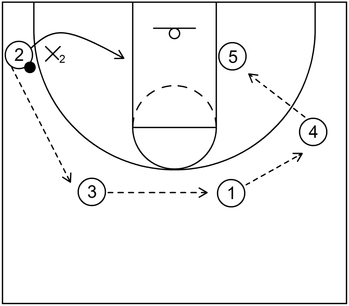
If 2 does not have any viable opportunities to score, then 3 could receive the ball from 2. When that occurs, this effectively triggers a continuity pattern within this particular form of box and 1 offense.
Next, 1 receives the ball from 3 and then 4 receives the ball from 1 via ball reversal action.
After that, 5 could possibly receive the ball from 4 and score with a low post move if that is available. Also, as that action occurs, 2 cuts to the left side low post block.
Example 1 – Part 5
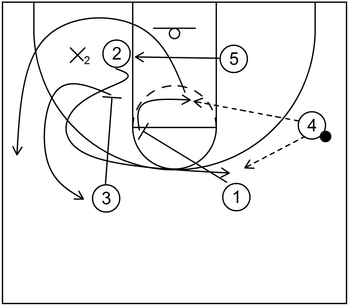
If 5 did not receive the ball, then 2 cuts to the right side slot area via stagger screens set by 1 and 3. Additionally, after setting the screens, 1 slips into the middle of the lane while 3 self replaces at the left slot area.
Moreover, at the same time, 5 cuts across the lane to fill the recently vacated left side low post area. Next, 1 could receive the ball and score with a short jump shot or by way of aggressively attacking the basket.
Furthermore, 2 could receive the ball and take the jump shot if open. Also, 1 should cut through to the left side wing area if 1 does not receive the ball from 4.
Example 1 – Part 6
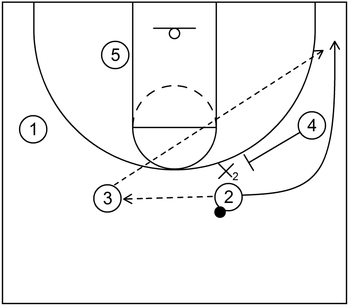
If 2 received the ball but the jump shot was not available, then 3 could receive the ball from 2. After that, 2 could cut away to the right side corner via the flare screen set by 4.
From that point, 2 could receive the ball via a skip pass from 3 and then take the open three-point shot. If that is also not open, then 4 would receive the ball from 2 and the continuity could get executed again.
Example 2 – Part 1
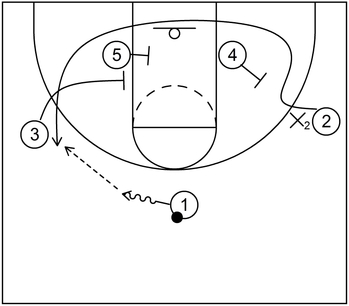
This is an example of a scoring option for the box and 1 offense derived from Baseline to Baseline Special Situations by Fran Fraschilla.
To start, 1 dribbles toward the left slot area and when that occurs, 2 cuts to the left side wing via a back screen set by 4 and double screens set by 3 and 5. After that, 2 receives the ball from 1 and could take the jump shot if open.
Example 2 – Part 2
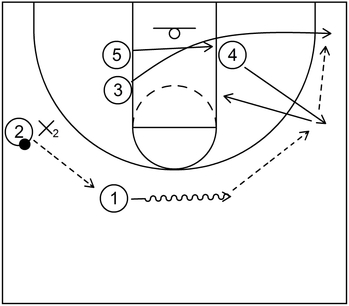
If 2 is not open, then 1 receives the ball from 2. Following that, 1 begins to dribble towards the right slot area. When that occurs, 3 cuts to the right side corner while 4 pops out to the right side wing area.
After that, 4 receives the ball from 1 and then, 3 receives the ball from 4. Next, 4 cuts to the right side mid-post area and at the same time, 5 cuts below the right side low post block.
Also, it is important that 4 and 5 cut at the same time because this creates an overload situation in which the bottom zone defender that protects the basket has to try to guard 4 and 5. When that occurs, it could lead to confusion and indecision by the basket protecting zone defender.
Example 2 – Part 3
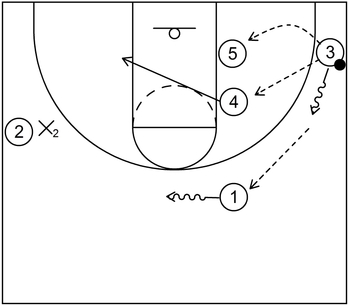
Next, 5 could receive the ball from 3 on the baseline low side, especially if the zone defender attempts to front, particularly on the high side.
In addition to that, 4 could receive the ball from 3 and take the mid-range jump shot or attack the basket as an alternative option.
If 4 and 5 are not open, then 3 could dribble back towards the right side wing. After that occurs, 1 could receive the ball from 3 and then dribble to the top while 4 cuts across the lane to the left side low post area.
Example 2 – Part 4
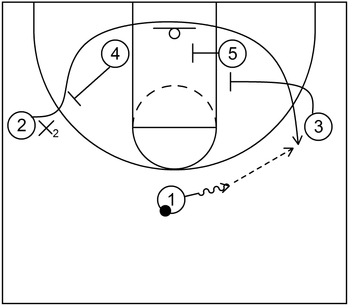
At this point, the offensive sequence could get executed again as a continuity pattern. Therefore, 1 dribbles to the right slot area. When that occurs, 2 cuts to the right side wing area via a back screen set by 4 and double screens set by 3 and 5.
Afterwards, 2 could receive the ball from 1 and take the jump shot if open.
Example 2 – Part 5
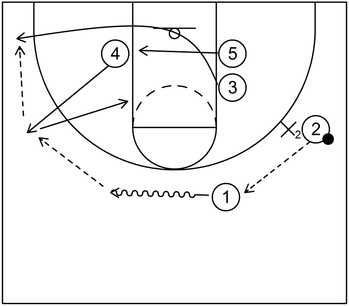
If 2 is not open, then 1 receives the ball from 2. Following that, 1 dribbles to the left slot area. As that occurs, 4 pops to the left side wing while 3 fills the left side corner.
After that, 4 receives the ball from 1 and then 3 receives the ball from 4. Next, 4 cuts to the left side mid-post and 5 cuts to the left side low post at the same time.
Example 2 – Part 6
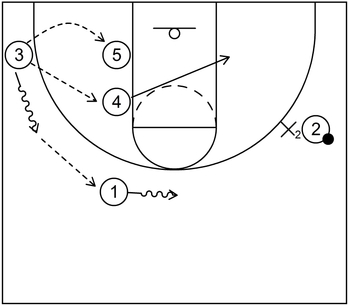
From there, 5 could receive the ball on the low side and score near the basket if that is open. Also, 4 could receive the ball and take the mid-range shot or attack the basket if that is available.
If 4 and 5 are not able to receive the ball, then 3 dribbles to the left side wing. After that, 1 receives the ball from 3 and then dribbles to the top to re-initiate the continuity once again.